Even the simple maintenance of a rabbit in an apartment requires the owner not only to care for the animal, but also to take preventive measures that will help maintain the health and cheerful disposition of the pet. One of these measures was the vaccination of these animals against myxomatosis and viral hemorrhagic disease. Rabbits are often vaccinated starting at 1.5 months of age.
A viral infection overtakes young offspring after a month and a half, even in a city apartment. The virus enters the body of a domestic rabbit along with food, water, or bites of blood-sucking insects. Therefore, vaccinations for rabbits and the time when they should be given should concern not only manufacturers of dietary meat and fluffy fur on an industrial scale, but also amateur rabbit breeders.
Myxomatosis in rabbits
Myxomatosis is an acute viral disease that affects domestic rabbits and their wild lagomorphs. Symptoms of the disease:
- serous-purulent conjunctivitis,
- the appearance of tumors on the head, in the external genital organs.
A disease affecting lagomorphs called myxomatosis has been known since the late 19th and early 20th century.
The main carriers of infection are blood-sucking insects: fleas and mosquitoes. Outbreaks of the disease occur from early spring to late autumn. They are associated with the mass reproduction of insects - carriers of infection. After infection, the latent period passes for about 2 weeks, after which the acute passage of the disease begins, ending in the death of animals.
Symptoms of myxomatosis
Symptoms of myxomatosis is an acute serous-purulent conjunctivitis, which suggests the presence of:
- edema,
- mucopurulent discharge,
- sticking eyelids,
- solid subcutaneous tumors on the head and external genitalia.
One of the symptoms of this viral disease was a head tumor that makes the rabbit's head look like a lion's head. The skin on the head of a sick rabbit gathers into rollers, forming deep folds, the ears drop, and the appearance of the animal changes.
Myxomatosis has two forms of the disease, and can take place in one of the forms: edematous or nodular. The edematous form can take from 4 to 28 days, and in nine cases out of ten ends in the death of the animal. With the nodular form, the disease lasts up to forty days.
If treatment is not carried out, then the mass death will be about 60% of animals.
Vaccination against myxomatosis in rabbits
Vaccination against body damage with this virus is carried out after weighing the rabbit. Its weight must be at least 0.5 kg. Vaccination against myxomatosis of rabbits for hares is harmless. It does not cause complications when all conditions for vaccination are met. It is administered intramuscularly or subcutaneously. After vaccination, the animal develops a tense immunity. Already from the third day after it, he is completely protected from viruses that penetrate his body. The duration of immunity after vaccination against myxomatosis is at least 12 months.
Viral hemorrhagic disease of rabbits
The first time viral hemorrhagic disease of rabbits appeared on the territory of modern Russia in 1986 on the border with China in the Khabarovsk Territory. Due to the fact that the disease was not studied, and its danger was underestimated, the infection quickly spread throughout the territory of the former Soviet Union. After studying all the symptoms of the disease and its features, a vaccine was obtained that could protect the livestock and their offspring from infection with the virus.
The disease is characterized by manifestations of hemorrhagic diathesis in all internal organs. The HBV disease is acute and leads to the death of livestock in a short time. The lungs and liver are especially affected. Infection with the virus occurs in domestic rabbits older than 1.5 months of age. They die two days after they appear. obvious signs diseases. From the moment of infection to death, only five to six days pass. Until then, the disease has progressed covert and does not give himself away. The breeder in such cases is powerless if he refused to vaccinate rabbits. Therefore, the age at which rabbits should be vaccinated is set at 1.5 months.
Viral Rabbit Hemorrhagic Disease and Vaccine
In the arsenal of veterinarians there is a specific vaccine against viral hemorrhagic disease of domestic rabbits, which has a protective effect that begins to act after 2 hours. It is administered subcutaneously or intramuscularly once at the very first signs of a viral infection of VGBK. Serum has a therapeutic effect in the development of primary clinical signs. The effect of the therapeutic effect of this serum under production conditions during the period of infection of the livestock with the virus is 93%. But the use of such a serum is not always possible due to domestic difficulties. In order not to risk business, it is recommended to use a preventive vaccine to prevent infectious diseases. It forms immunity in vaccinated individuals from 1.5 months of age after a single injection. Vaccination for rabbits begins to act on the 3rd day and has a duration of 12 months.
The vaccination scheme against myxomatosis and VGBK in areas with a high degree of infection risk is as follows:
- Primary vaccination 1.5 months with a weight of 500 grams.
- Revaccination takes place at 4.5 months.
- Re-vaccination occurs every 9 months.
Vaccination rules
- Vaccination is carried out in order to immunize healthy individuals once, starting from 1.5 months of age.
- Rabbits are vaccinated at any time during pregnancy.
- In areas with a high risk of infection with myxomatosis and HBV, healthy individuals and rabbits begin to vaccinate from 45 days of age. Re-vaccinate after 3 months. Repeatedly domestic and decorative rabbits are vaccinated after 9 months.
- It is forbidden to vaccinate sick animals.
Rabies vaccination for a traveling rabbit
Rabies vaccination is not required for a traveling rabbit. Most importantly, the rabbit should be vaccinated against HBV (required for obtaining a certificate) and against myxomatosis (so that it does not become infected during transportation). It is also necessary to donate feces for helminth eggs and salmonellosis in advance (2-3 weeks in advance). Otherwise, the sanitary epidemiological surveillance will not let him go abroad. Without a certificate of vaccination and research, they are not allowed to board either the plane or the train car.
Anthelmintic measures before vaccination
Be sure, before each vaccination, rabbits need to drive out the worms. Worm infestations, both in domestic and decorative rabbits, greatly lower the body's immune defenses, causing all sorts of heart complications and other diseases. Before vaccination, the breeder must necessarily carry out the prevention of helminthiasis.
Complications after rabbit vaccination
There are no complications after vaccinations, if you do not violate the rules described above. The creators of the vaccine against myxomatosis and viral hemorrhagic disease claim that it is completely safe. If you do not vaccinate a small dwarf rabbit weighing less than 0.5 kg, or a small rabbit with a small weight, sick individuals, then the vaccination will not give complications. Expelling worms - milestone successful vaccination. To the question: "Vaccinations for rabbits, when to do?" - not given too late, vaccinate rabbits in a timely manner.
Rabbits are in the hare family. The main difference from hares is that rabbits are born naked and blind, so they are raised in nests. The life expectancy of an animal is 10-12 years. The weight of rabbits ranges from 0.5 to 2 kg, height is 20-50 cm.
Rabbits were domesticated around 2,000 BC. in Europe (on the Iberian Peninsula). A little later, the Romans brought them to France and England. Today, agricultural and decorative breeds are distinguished.
Rabbits can be vaccinated against two diseases: myxomatosis and viral hemorrhagic disease. In veterinary pharmacies, you can buy a vaccine against one of these diseases or a complex one (that is, from two at once). They should be stored in the refrigerator at a temperature of plus 2-4 degrees.
Having bought the vaccine is not all, after that you need to determine who will vaccinate the animal. There are several options here. First, you can make an injection yourself, though without special knowledge this is hardly possible.
The second option is to take the rabbit to the veterinary clinic, but what if there are a hundred or even 200 rabbits?
Option number three, call the veterinarian to the rabbitry, where he can vaccinate all the rabbits on the spot, after examining them.
Myxomatosis and VGBK are diseases that are practically impossible to cure. They are required to be vaccinated. Before each vaccination, you need to get rid of the worms in rabbits. They reduce immunity, which can cause complications in the heart and kidneys. Responsibility for this lies entirely with the owner of the animal.
There are several factors to consider before vaccinating rabbits. Rabbits must be absolutely healthy, a sick rabbit cannot be vaccinated; vaccination can only worsen the situation. It is best to have a doctor examine them before vaccination.
The first vaccination of rabbits should be carried out at the age of at least 45 days. The weight of the rabbit must be at least 500 g. Pregnant and lactating females should not be vaccinated.
Comprehensive vaccination must be done strictly according to the scheme. It looks like this. The first vaccination - occurs at 1.5 months. The second vaccination - at 4.5. The third and subsequent - every half a year. Of course, not one of the vaccinations does not give a 100% guarantee, but it significantly reduces the risk of disease, and hence the death of the pet.
How should the owner of the animal behave after its vaccination? Since immunity is not developed immediately, but within two weeks. It is best to isolate the vaccinated animal at this time.
Side effects of vaccination. There was a slight decrease in appetite, lethargy, drowsiness and apathy, for a short period of time. Despite all this, vaccinations are simply necessary, otherwise the animal will die.
Sometimes it becomes necessary to vaccinate a rabbit against rabies (for example, while traveling). In order to make such a vaccination, you must definitely contact a veterinary clinic. True, signs of rabies in rabbits have not been observed to this day.
Rabbits can see what's happening behind them without having to turn their heads. The long-lived rabbit died at the age of 19. The longest ears of a rabbit were 80 cm. The longest jump of a rabbit was 3 meters. Rabbits have 28 teeth.
A comprehensive vaccination for rabbits was developed several years ago to facilitate the process of vaccinating animals. Instructions for use of the vaccine from VGBK I M was approved on February 5, 2002 by the Department of Veterinary Medicine. You can familiarize yourself with them before buying a vaccine at a pharmacy; it must be enclosed in a box with an ampoule.
Vaccination is usually carried out intramuscularly, subcutaneously or intradermally. Immunity is developed on the 3rd day already, lasting at least 12 months. After the vaccination, an act is drawn up, which must record the date of the event, the condition of the animal before vaccination, the number of animals, the date of manufacture, the series and number of this vaccine, the name of the manufacturer of the drug, the names of veterinarians and the condition of the rabbits after vaccination.
If any adverse reactions are detected, vaccination with this drug should be stopped immediately. There is an opinion that complex vaccinations are worse tolerated than mono-vaccinations. This drug has less side effects, immunity is developed faster, the vaccine is easier for animals to tolerate. The main plus is that the animal is vaccinated against two diseases at once.
What vaccination to choose mono or complex. Vaccinate yourself or contact a veterinary clinic. The choice is up to the owner of the rabbit. But the question is to vaccinate or not? The answer should be only one - of course yes.
Rabbits that are bred as pets or decorative pets, like other animals, need to be vaccinated. It is vaccinations against the most common viral diseases of animals that will not only prolong the life of a pet, but also secure a person's stay next to a pet.
Why is it important to vaccinate rabbits?
Pets such as rabbits are very susceptible to various infections. And even the constant year-round presence of a pet indoors will not save him from the development of the disease.
Even the most common pet diseases, such as worms and myxomatosis, lead to the death of the animal in 99% of cases.
In order to maximize the life of your beloved eared friend, experts advise to carry out preventive vaccination of animals. The procedure is practically painless for the pet, and is performed approximately every 9-12 months, depending on the vaccine. The only condition for vaccination is that you need to be completely sure that the rabbit is absolutely healthy.
What diseases should rabbits be vaccinated against?
Rabbit is vaccinated
There are a number of diseases that pets such as rabbits are most susceptible to. We advise you to familiarize yourself with them and possible signs of disease:
- Salmanellosis (paratyphoid). This disease can occur in almost any pet. The main signs of the disease are refusal to eat by animals, accompanied by vomiting or diarrhea. In this case, it is necessary to vaccinate against the Salmonella virus.
- Pasteurellosis is usually accompanied by a high temperature of the animal, fever and pneumonia. A young animal is most often vaccinated against this viral disease, it is worth noting that females are vaccinated only in case of a disease.
- Rabbit rabies strikes their central nervous system and leads to the death of the animal.
- Listeria often occurs in female rabbits. With this disease, the rabbits change in behavior, become apathetic, refuse to eat.
It should be noted that in the event of rabies and listeriasis in places of mass breeding of rabbits, all animals are vaccinated in order to avoid cases of mass infection with the disease.
What vaccinations do rabbits need?
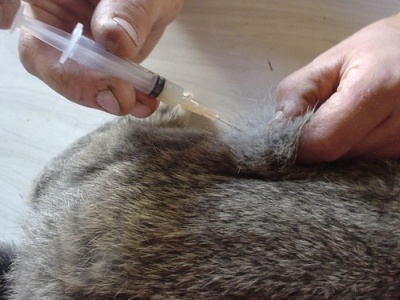
Vaccinate a rabbit against myxomatosis
The most common vaccines given to rabbits are for and against myxomatosis. 2 methods of the most effective vaccination of animals have been developed:
Vaccination of an animal of a general type occurs as follows:
- at the age of 45 days, the first vaccination is made;
- the second vaccination must be administered no later than 3 months after the first;
- every subsequent 5-6 months it is necessary to revaccinate to consolidate the immunity of the animal.
Vaccination of an animal against HBV and myxomatosis should be carried out according to the schedule:
- at the age of 45 days, the first vaccination against HBV is given;
- after 2 weeks, a vaccination against myxomatosis is performed;
- after 3 weeks, vaccination against myxomatosis is repeated;
- after 2 weeks, the final vaccination of the rabbit against HBV is performed.
It should be noted that subsequent vaccination of the rabbit must be done every six months. In this case, only you can protect your pet from the harmful effects of viruses as much as possible.
How to prepare for vaccinating rabbits
For any vaccination of an animal, it is necessary to prepare in advance. Firstly, it is necessary to examine the animal for possible diseases, since vaccinating a sick animal may not only have no effect, but also aggravate the situation with the course of the disease. Secondly, a week or two before vaccination, you need to give the rabbit a deworming drug for prevention.
If you have just acquired a rabbit, you should not immediately vaccinate. It is best to arrange an incubation period for your pet. Within a week or two, observe the animal, if there is no suspicion of any disease, you can vaccinate the rabbit.
Rabbit vaccination process
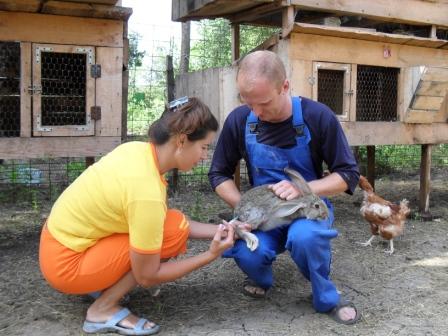
Farm rabbit vaccination
Rabbits can be vaccinated both in special institutions, such as veterinary clinics, and at home.
As for the vaccination of rabbits in veterinary institutions. We recommend that you be present during the vaccination process. Firstly, you will be able to control the sterility of syringes, the availability of the vaccine and, in fact, the vaccination itself, and secondly, try to learn as much as possible about the drug that the animal is vaccinated with. Ideally, take an extract about how the animal was vaccinated. This may be necessary if a reaction to the vaccine occurs.
Most often, after several vaccinations of rabbits, their owners wonder if it is possible to vaccinate at home? The answer is simple - of course you can! Firstly, it will save your time, and secondly, it will significantly save money. But, before you carry out the procedure for vaccinating a rabbit, try to watch the corresponding video or get advice on the correct vaccination from a veterinarian.
To vaccinate at home, you will need the appropriate vaccine and an insulin syringe, which can be purchased at any pharmacy. On average, a single injection is a dose of 0.5 ml, and the vaccine is diluted with ordinary water. The injection itself is injected into the area of the withers of the animal under the skin or into the area of \u200b\u200bthe hind leg of the rabbit. Before vaccination, be sure to disinfect the injection area. It is also necessary to observe the storage conditions of vaccination, the expiration date and storage methods are described by each manufacturer of the antiviral drug.
The action of the vaccine for the rabbit
In order for a rabbit to gain immunity against any possible infection, a strict vaccination schedule must be followed. But what does the vaccine do in the animal body? How does it help block the onset of the disease?
The vaccine, introduced into the body of an animal, contributes to the production of antibodies to specific infections and viruses. Also, it is the antibodies produced by the body that contribute to the death of already existing infection bacteria. So, if an infection enters the body of a vaccinated rabbit, antibodies are already ready to fight it. If the rabbit is not vaccinated, it takes much more time and effort to fight the virus, and sometimes the animal's body is simply not able to cope with the disease.
Activities that are necessary after vaccination of a rabbit
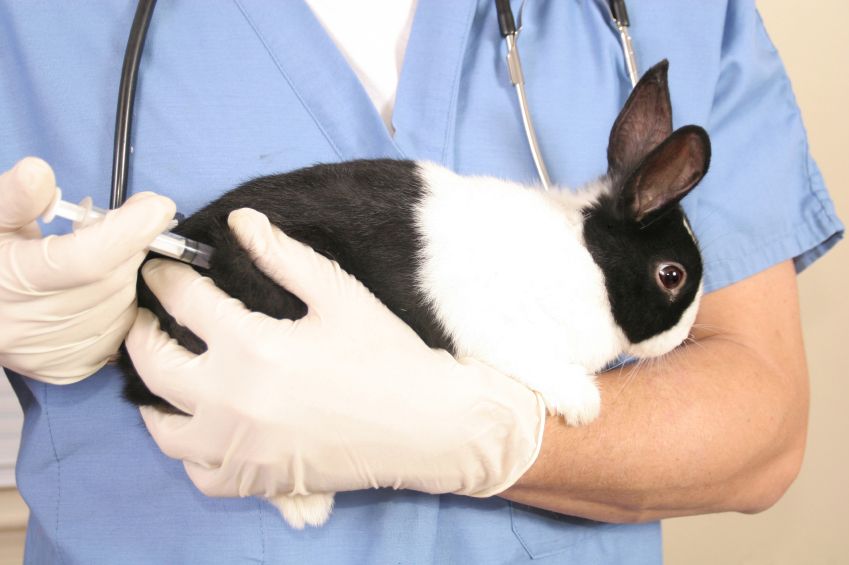
Vaccination is a rather complicated process in terms of the necessary measures. After vaccination, the rabbit must be kept for at least a week in strict quarantine. Since it is at the moment when the body produces antiviral antibodies, the animal is most susceptible to infections entering the body. Be sure to monitor the behavior of the pet. If the rabbit becomes lethargic after vaccination, refuses to eat, be sure to contact your veterinarian.
As for the nutrition of the animal, there are no questions here, food can be normal, but there should be a little more water, since rabbits consume more liquid after vaccination. Also side effect after vaccination of rabbits, profuse salivation of the animal may become, but this is just a reaction to the components of the vaccine. As a rule, this is not a cause for concern, and the symptoms disappear after a day or two.
How long does the vaccine last
It is recommended to vaccinate rabbits at least once every six months. Accordingly, the stable immunity of the animal to the pathogens of a particular disease is maintained throughout the period between vaccinations, that is, up to 9 months. Further, the risk of a harmful infection entering the pet's body increases. The period of action of the administered drug depends individually on each animal and on the brand of vaccine used.
Which rabbits should not be vaccinated
There is an opinion that adult rabbits that have not been previously vaccinated should not be vaccinated, because it can have a detrimental effect on the body. We hasten to assure you that this opinion is nothing more than another myth. Animals tolerate vaccination equally at any age. Just as animals are susceptible to the action of disease, they are also the same. As for female animals, it is better not to vaccinate pregnant rabbits and females during feeding. Wait for the weaning of the rabbits and vaccinate the animal.
Video on how rabbits are vaccinated
Most people who breed rabbits sooner or later encounter infectious diseases of these animals. Knowing how to prevent or treat the disease will help to maintain the number of livestock and avoid losses.
And most often alone, they are more at risk of becoming infected by contact with the pathogen. Reduced immunity is the price for many years of selection.
rabbits. When an outbreak occurs, the entire population quickly falls ill. Effective treatment not developed, and lethality reaches 100%. The best means of combating myxomatosis is preventive vaccination of animals.
Rabbit myxomatosis Rabbit myxomatosis Rabbit myxomatosis
Pathogen and transmission routes
Myxomatosis is viral in nature. The causative agent is quite stable in the external environment, so the disease can be transmitted by contact- by direct contact with a sick animal, through food, bedding, hands of the breeder. Another transmission route is transmissive, i.e. through the bites of blood-sucking insects (fleas, mosquitoes, midges, gadflies). The incubation period, when the rabbit is already infected, but there are no external signs of the disease yet, lasts from 3 to 15 days. This is important to consider before vaccination and during quarantine.
Manifestations of myxomatosis
There are two forms of the disease. The first sign in any form of myxomatosis is the appearance of red spots or nodules on the skin of the ears, around the eyes, or on other parts of the body.
- Edema. It begins with an increase in body temperature to 41 degrees C, which lasts until the first signs of the disease appear. First, conjunctivitis develops - the eyelids of the animal turn red, a purulent secret is released from the eyes. Then a runny nose with copious discharge from the nose joins, the rabbit's breathing becomes noisy, heavy. Tumors appear all over the body, 3-4 cm in diameter. The disease proceeds within 4-10 days, sometimes up to a month. Accompanying pneumonia usually leads to death.
- Nodular. It proceeds more benignly, half of the diseased individuals survive. Numerous dense tumors appear on the skin of a rabbit, ranging in size from 5 mm to several centimeters. Body temperature does not rise. 14 days after onset, if the rabbit survived, the tumors begin to die. Foci of necrosis (dead tissue of the tumor) heal within 2-4 weeks.
Animals that have been ill become immune to this disease and, in most cases, do not get sick again.
Prevention of myxomatosis

Myxomatosis in a rabbit
The only thing effective remedy protect rabbits from myxomatosis - preventive vaccination. For its implementation, two types of vaccines are used:
- Vaccine against myxomatosis dry live cultural from the strain "B-82" - protects only against the causative agent of myxomatosis.
- The vaccine associated against myxomatosis and - protects against pathogens of these diseases.
A vaccine is not a cure, but a means of prevention! It causes the formation of immunity by introducing weakened pathogens (viruses in this case) into a living organism. It is pointless and even harmful to vaccinate already sick animals.
Age of start of vaccination
Vaccinate rabbits when they reach 28 days of age, adults, pregnant and lactating females (vaccination is not recommended in the last stages of pregnancy). If the rabbit has a weight of less than 500 g, vaccination is postponed until this weight is gained.
Vaccination schedule
- The first vaccination - at 28 days;
- revaccination - after 3 months, i.e. at the age of four months;
- subsequent revaccinations - after 6 months in areas unfavorable for myxomatosis, after 9-12 months - in favorable ones.
The same scheme is observed in the case of vaccination of adult rabbits. Revaccination is recommended in spring and autumn, since it is during these seasons that the incidence of myxomatosis increases. If the revaccination time has been missed, then it is necessary to vaccinate the rabbits as soon as possible, regardless of the season.
Vaccination technique
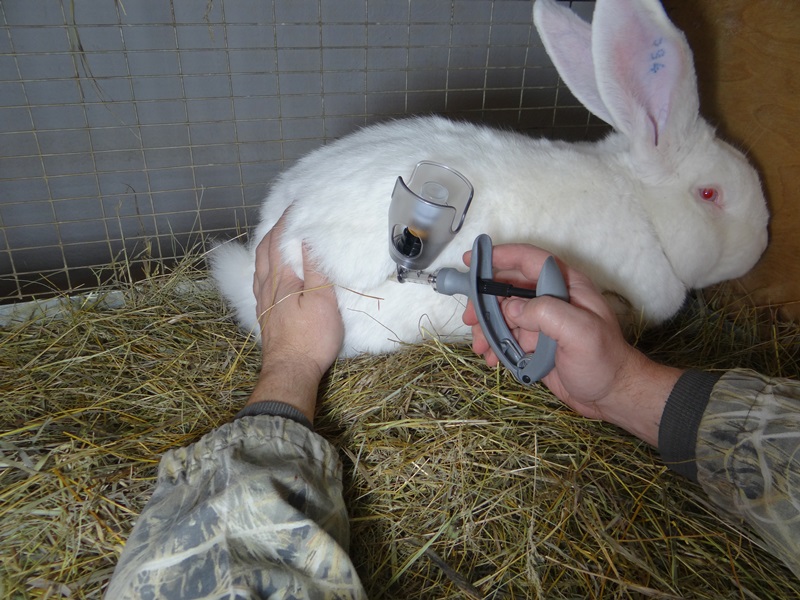
Vaccination of rabbits against myxomatosis
Only healthy animals are vaccinated. Two weeks before the planned vaccination or after it, it is recommended to give rabbits an anthelmintic preparation.
The formation of immunity begins on the 3rd day and ends on the 9th. The protective effect lasts from 9 to 12 months.
The vaccine is given:
- Intradermal - in the middle part of the auricle, so as not to touch the blood vessels. The skin is pierced by a few mm with a needle, it is necessary to achieve the appearance of a “button”, as in the Mantoux test. You can use a needleless injector. 0.2 ml of vaccine is administered.
- Subcutaneously - in the thigh area. 0.5 ml of the drug is injected. It differs from intramuscular injection by the depth of needle insertion (introduced to a shallower depth).
- Intramuscularly - the area of injection and the volume of the drug is the same as with subcutaneous administration of the drug, but the needle is inserted a few cm deep.
An individual needle is used for each rabbit. When using reusable syringes and needles, they must be sterilized by boiling for 15-20 minutes. Cannot be sterilized chemicals. The needleless injector is processed by the method specified in the instructions.
The injection site is treated with 70% alcohol or other skin antiseptic. The vaccine is diluted with saline at the rate of 0.2 ml of saline per dose for intradermal administration and 0.5 ml per dose for subcutaneous / intramuscular injection.
See clearly how to vaccinate a rabbit yourself in the video clip.
Complex vaccine
Protects animals from myxomatosis and viral hemorrhagic fever. Simplifies the vaccination process, but is not recommended for use in areas unfavorable for these diseases. After it, less intense immunity is formed. The vaccination schedule and technique are the same as for the myxomatosis vaccine.
Complications of vaccination
The risk of their occurrence increases if the rules for vaccinating animals are not followed. The following complications are possible:
- Infiltration, abscess (limited cavity filled with pus) at the injection site - if asepsis rules are not followed and rabbits are not properly cared for;
- Allergic reaction on the drug - occurs more often in rabbits affected by worms;
- The disease in a mild form is possible when vaccinating a weakened animal, underweight (up to 500 g), pregnant females in the last stages and lactating females.
Effectiveness of vaccination
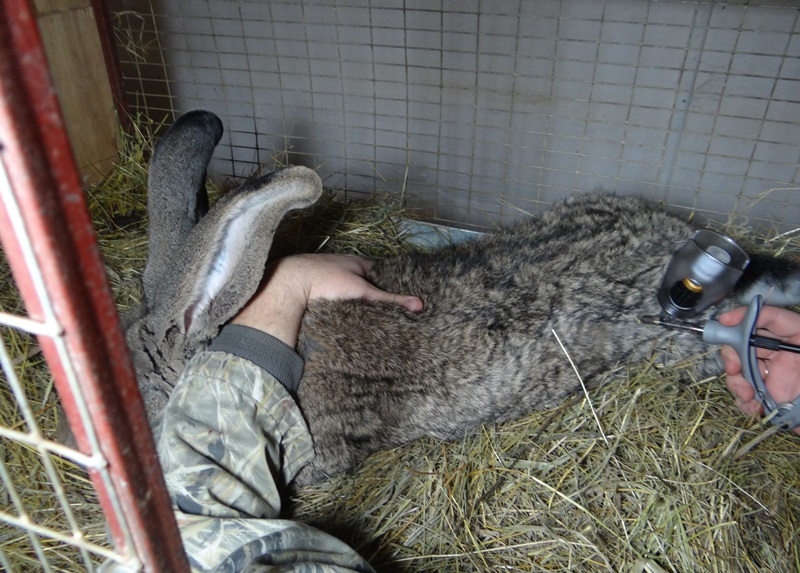
Rabbit being vaccinated against myxomatosis
The vaccine does not provide a 100% guarantee of protecting animals from myxomatosis, but significantly reduces the risk of death. The formed immunity will allow the rabbit to transfer the disease much easier.
In order to be sure of the vaccination, it is necessary to strictly follow the rules for the storage and use of the drug:
- store the vaccine in the refrigerator, at a temperature of 0 to 5 degrees C;
- the diluted drug must be used within 1 hour;
- you can not administer the vaccine, with any signs of violation of the integrity of the ampoule or vial;
- pay attention to the expiration date, the expired drug should be disposed of.
The cost of vaccines
On the territory of the Russian Federation, you can purchase vaccines from the Pokrovsky Plant of Biological Products. The price of the myxomatous vaccine is 32 rubles for 10 doses (1 ampoule), the associated vaccine is 187 rubles for 10 doses (1 ampoule).
Vaccines of foreign manufacturers:
- Lapimun mix, lapimun gem - Ukraine;
- Mixoren - Czech Republic.
